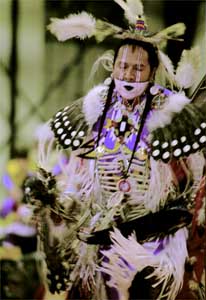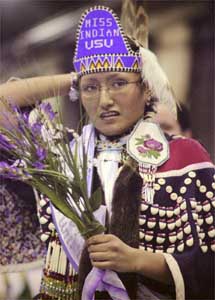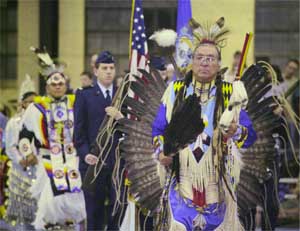Annual Pow-Wow dances at Fieldhouse
Students passing the Nelson Fieldhouse Friday and Saturday, may have heard the beating of drums and, rising above them, the chant of Native American traditional songs.
Last week the annual Native American Pow-Wow, organized by the Utah State University Native American Student Council (NASC) filled the Fieldhouse with the sights, sounds and even some of the tastes of Native American culture.
Sponsored by many campus and community organizations, the Pow-Wow is held annually to educate the community about Native American culture, to give young Native Americans the opportunity to participate in the dances and customs of their heritage, and to provide an event for everyone, particularly Native Americans, to socialize and meet new friends, said NASC member Orlando Norton, a junior in forestry at USU.
“This is the biggest event the council organizes,” Norton said. “We’re happy to get a lot of help from the community and USU departments.”
The Pow-Wow includes several events, such as the Miss Indian USU pageant; a coloring contest involving hundreds of middle school students; vendors selling jewelry, food, crafts, and artwork; and perhaps the most definitive part of the event – the dance competitions.
While the dances may be baffling to the average spectator, the categories of dances are actually very specific, and each dance is full of symbols and stories relating to the origin of the dance. The dancers were happy to enlighten others with some facts about the categories.
The “Grass Dances,” for example, originated when Native Americans of the Plains congregated in open, grassy areas to socialize, and invited dancers to stomp down the grass prior to the meetings, said Miss Indian USU Tavia Natchees, a freshman in business management.
The “Jingle Dances” are done by women wearing regalia covered in 365 jingles, one for each day of the year, and originated as a medicine dance done by girls to cure their ailing fathers, Natchees said.
To show respect for the nature of the dances, the dancers refer to their garments as regalia. The clothing “is very important to him or her for various reasons. Many hours go into the intricate beadwork and detailing; a full set of regalia may take years to complete,” according to an informational brochure distributed by NASC.
Natchees’ own costume displayed the floral patterns her tribe (Northern Ute/ Ute Mountain Ute) is known for, and a single feather in her headband, indicating she is unmarried. The dance competitions bring about 100 dancers from locations as far as Canada, said NASC member and USU graduate Antonio Arce.
“Last year we had 30 nations represented,” Arce said.
Among the attendants of the Pow-Wow was Nino Reyos, one of the Indian flute players who participated in the Opening Ceremonies of the 2002 Olympics.
“I think events like this are important because they break a lot of the negative stereotypes associated with Native Americans,” Reyos said. “[Pow-Wows] show people that we are still proud of our culture that we still exist as a culture, and that we will continue to dance in our circles.”
The dancers begin their love for dancing at a young age, Reyos said.
“The dances are ingrained in them from the beginning,” Reyos said. “Many of their mothers danced at Pow-Wows pregnant, or with their babies on their backs. As they get older, they are trained to learn and enjoy dancing.”
Mele Lamelangi, a high school junior from Brigham City, did a Jingle Dance at the Pow-Wow.
“My uncle was a drummer at Pow-Wows, and he introduced me to the ‘Pow-Wow trail’,” Lamelangi said. “We love to dance and compete, and also to meet other people at Pow-Wows. When there’s not a Pow-Wow for a couple months, or even for a few weeks, you start to miss it.”
“There are 60 prizes available to winners of dance competitions,” Arce said. “The prize money just barely covers the cost of travel for most of the dancers. Many are sacrificing time and money just to come.”
NASC member Alex Gouley, a USU graduate, said, “We also have dances at the Pow-Wow where we invite anyone to dance with us. Whatever your culture, you can come into the circle and dance any way you like.”
The NASC hopes the Pow-Wow will help it to accomplish some of its goals as an organization, including providing social and educational activities for Native Americans, USU students, and communities of Cache Valley, and recruiting people to serve on NASC,” Norton said.
While most NASC members are of Native American heritage, anyone interested is welcome to become a member, Arce said.
“We want to support community involvement and diversity, and show people that Utah State University is a culturally diverse place,” Norton said.
Bird Osborne, the designer of the Pow-Wow’s fliers, said, “We feel the Pow-Wows bring people together, and help the younger generation to feel closer to their culture. We hope everyone will continue to dance.”
To find more information about the Native American Student Council at USU, call 797-2891, or visit http://multiculture.usu.edu/org.

Fabian Fontenelle dances in an open dance Friday. (Zak Larsen )

Utah States University´s new Miss Indian, Tavia Natchees leads a dance at the event. (Zak Larsen )

Lorren Sammaripa leads the flag around the floor of the Fieldhouse as part of the flag ceremonies Friday the the 29th annual Pow-Wow. Sammaripa has been involved since the Pow-Wow began. (Zak Larsen )

